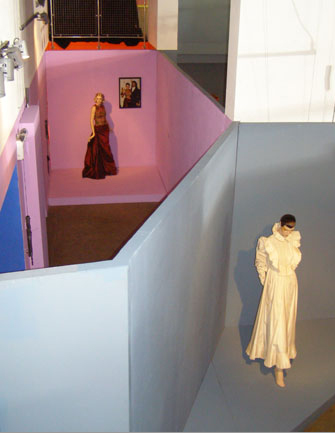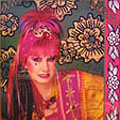Tea With Zandra Rhodes
Report by Margaret Burgess
and Alexandra MacCulloch
March 2006
On a bitterly cold March day we arrived in Bermondsey, south of the Thames, for
a visit to the intriguing and unique Zandra Rhodes Museum and a personal tour by
the designer herself. Famous for her vibrant, bold prints and startling use of slashing,
Zandra Rhodes decided to open the Museum in 1995 as a place where her designs and
those of others could be exhibited, where students could study 20th century fashion
firsthand and where students could apprentice.

She met us in one of the many workrooms in the designer’s haven, with her hot pink
hair, fingers bedecked with rings, and blue eyes ablaze with excitement. But perhaps
the characteristic that was most striking was Zandra’s generosity of spirit and
openness of character. She was a generous and consummate host.
The Museum itself
was like the designer—bold, eclectic, and dynamic! The building, painted in striking
hues of orange and pink is the work of renowned architect Ricardo Legorreta. It
houses not only the Museum but also Zandra’s offices, workrooms, screen printing
room and own living quarters.
We began in the Museum proper exploring the main display
space where examples of Zandra’s work were displayed with dresses by other designers
donated to the Museum, such as Dior gowns from the fifties and the Ellie Saab dress
worn by Halle Berry to the 2005 Oscars.
Because we were there while the Museum was
closed to the public our visit had all the delights of a personally conducted behind-the-scenes
tour. In one section of the upper galleries a photo shoot of the current collection
was taking place with the model striking many poses in one of Zandra’s versatile
caftans with a lace design. In another area, Zandra unfolded dresses from boxes
which had just returned from another exhibition—from these treasure chests came
iconic examples of Zandra’s work; her ‘holy sari’, an Egyptian inspired caftan,
the ‘Indian Feather’ print dress and a ‘Button Flower’ print jacket, each demonstrating
the multitudinous influences that have inspired her work, from Victorian lace to
the feathers of a peacock, from Europe to Asia.

In the rooms behind the display space
we were able to browse Zandra’s sketchbooks, where bold and fanciful designs (she
designs two collections a year) and images from her travels to India, China, and
other exotic locales were sketched on Japanese writing paper. Down and around another
corridor, Zandra also led us to her screen printing room where the worktable stretched
for 20 feet and the original silkscreens for her prints were stacked rack upon rack.
Using every available inch of space, the table itself was built high above the floor
so that trunks of clothes could be stored underneath.
But that was just the Museum!
At the end of the tour, Zandra treated us to tea in her private rooms upstairs—a
vibrant Mecca effusive of her creative spirit, replete with murals and sculptures,
amazing candelabras and an outside terrace. The juxtaposition of traditional tea,
jam and scones and that setting was priceless, notwithstanding the presence of the
doyenne herself, teapot in hand.
After such a glorious and fascinating tour it is
a great sadness to learn that the Museum, such a delight to its creator and many
others who have loved her work over many years, will close.